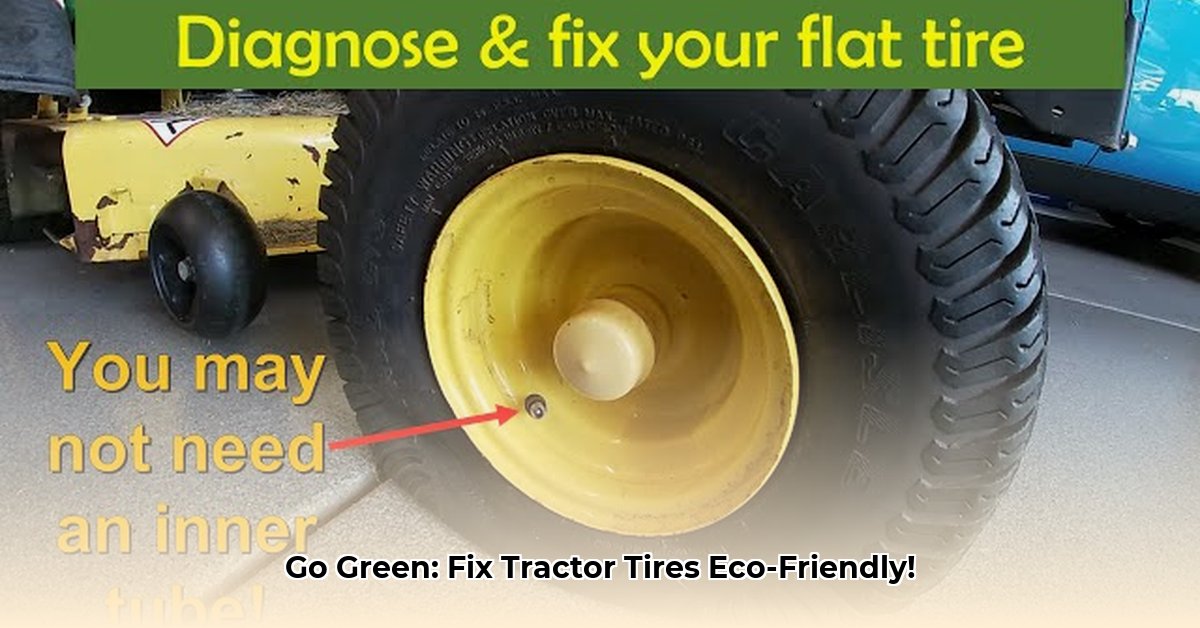
Keeping your tractor tires in optimal condition is paramount for efficient and sustainable farming. A flat tire can halt operations, leading to lost time, reduced yields, and increased costs. This guide provides a comprehensive approach to fixing flat tractor tires, emphasizing preventative maintenance and environmentally conscious practices. For more information on a specific repair, see our guide on valve stem replacement.
Preventative Maintenance: Proactive Tire Care
Regular tire inspections are crucial for avoiding costly downtime. Under-inflation is a frequent cause of premature wear and increased puncture risk. Conversely, over-inflation can lead to dangerous blowouts.
- Weekly Pressure Checks: Use a reliable gauge to ensure your tires are inflated to the manufacturer's recommended pressure (usually found on the tire sidewall).
- Thorough Inspections: Regularly inspect your tires for cuts, embedded objects (nails, stones), bulges, or any signs of unusual wear.
- Avoid Overloading: Overloading your tractor puts excessive stress on the tires, significantly shortening their lifespan and increasing the likelihood of flats. Adhere to your tractor's weight capacity guidelines.
Assessing the Damage: DIY or Professional Repair?
Before attempting any repair, carefully assess the extent of the damage. Minor punctures might be manageable with a DIY approach, while more significant damage often demands professional intervention.
| Damage Type | DIY Repair? | Professional Repair? | Rationale |
|---|---|---|---|
| Small puncture (nail) | Yes | No | Clean, patch, and re-inflate; simple, cost-effective solution. |
| Large puncture | Maybe | Yes | Consider sealant as a temporary fix; large holes usually require professional patching. |
| Sidewall damage | No | Yes | Sidewall damage compromises structural integrity; replacement is typically necessary. |
| Tread separation | No | Yes | Severe structural damage; professional assessment is essential for safety. |
This risk assessment matrix helps farmers make informed decisions based on the severity of the damage and their own capabilities. Remember, safety should always be prioritized.
DIY Repair Guide: Step-by-Step Instructions (for Minor Punctures Only!)
Disclaimer: This guide is for minor punctures only. Attempting to repair significant damage can be dangerous and potentially lead to further tire damage.
- Safety First: Engage the parking brake, chock the wheels, and wear work gloves.
- Wheel Removal: Use the appropriate wrench to remove the affected wheel. Refer to your tractor's manual for specific instructions.
- Locate the Puncture: Remove the inner tube (if applicable) and locate the puncture using soapy water to reveal air bubbles.
- Cleaning: Thoroughly clean the area around the puncture with a wire brush or sandpaper.
- Patch Application: Apply the patch according to the manufacturer's instructions and ensure a secure bond to prevent future leaks.
- Reassembly: Carefully re-install the inner tube (if applicable) and remount the tire onto the wheel. Use a tire iron or other appropriate tools.
- Inflation: Inflate the tire to the recommended pressure, using a reliable pressure gauge.
Tire Sealants: A Critical Evaluation
Tire sealants offer a quick, temporary fix for minor punctures, but they are not a permanent solution. They’re best viewed as a short-term measure to get you back up and running while a proper repair is scheduled.
Advantages:
- Convenient and quick temporary repair.
- Minimal effort required.
Disadvantages:
- May not work on all puncture types or sizes.
- Can interfere with future repairs by reducing puncture detection clarity.
- Some sealants may damage the inner liner of the tire over time.
- Environmental concerns with improper disposal.
- Not a long-term solution.
Sustainable Practices: Minimizing Environmental Impact
Sustainable farming extends to responsible equipment maintenance. Choosing durable, high-quality tires minimizes replacements and reduces landfill waste. Regular preventative maintenance significantly reduces the overall need for repairs and replacements.
- Tire Selection: Opt for durable tires with extended lifespans. While initial cost might be higher, the long-term savings and environmental benefits generally outweigh this factor.
- Responsible Disposal: Research and utilize local tire recycling programs to ensure proper disposal.
- Retreading: Where feasible, explore tire retreading as a cost-effective and sustainable method of extending tire life.
When to Call a Professional: Recognizing Limitations
For major damage, complex repairs, or situations requiring specialized equipment, seek professional assistance. Attempting complex repairs without the proper knowledge or tools can be dangerous and may lead to more extensive damage. Don't hesitate to contact a tire professional when needed.
Key Takeaways:
- Preventative maintenance is paramount for avoiding flat tires and maximizing tire lifespan.
- Assess damage carefully; DIY repair is suitable for minor punctures but professional help is crucial for serious damage.
- Tire sealants provide temporary fixes but lack long-term sustainability.
- Sustainable farming encompasses responsible tire selection, maintenance, and disposal.
This guide empowers farmers to make informed decisions about tractor tire maintenance, promoting both operational efficiency and environmental responsibility. Remember, the right approach balances short-term expediency with long-term cost-effectiveness and environmental sustainability.